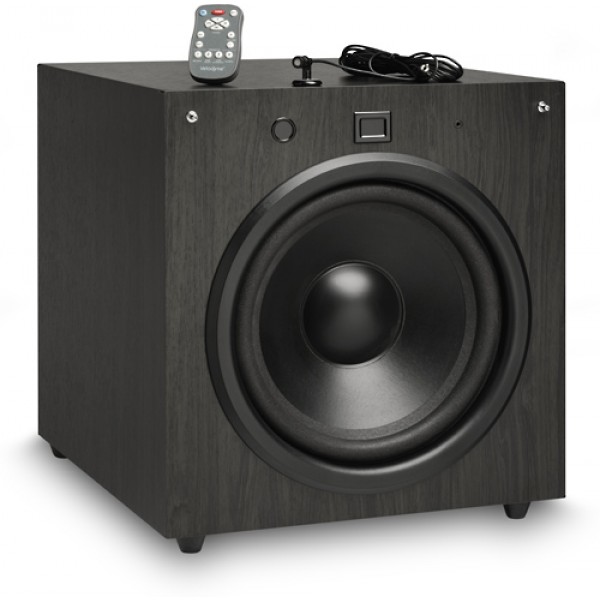There are many ways to design a subwoofer enclosure. In our view, there is no one “correct” way to design a subwoofer. Rather, there are many design approaches, and some designs work better at certain price points. Each design can have a good or bad result, depending on how it is implemented.
All subwoofer design involves trade-offs, and so determining at the start what result we desire is key to building a good subwoofer. What do we want this subwoofer to be? Should it be inexpensive, and sound as good as possible for the price? Is it a “cost no object” exercise in great sound? Do we want a small subwoofer that performs like a larger one?
Several key tradeoffs are involved in designing a subwoofer, as follows:
1. Cabinet Size: The larger we make the subwoofer cabinet, the more air there is to work with, so the more efficient we can make the subwoofer. However, some consumers object to a larger cabinet. So, many subwoofers are designed specifically to take up very little space. Getting great bass from a small cabinet is not an easy task.
2. Cost: How much will the product sell for at retail? The more we invest in quality materials, the better we can make the subwoofer sound, and the better its deep bass performance can be. More amplifier power can produce louder volume levels, but a big amp will likely cost more than a less powerful one.
3. Efficiency: How loudly do we want the subwoofer to play, given a specific cabinet size? With one watt of amplifier input, how much sound pressure can we measure at a one meter distance? The larger the cabinet, the less amplifier power it takes to reach a given sound pressure level. But as we know, a large cabinet may or may not be an option for the space-conscious consumer.
4. Deep Bass Accuracy: What are the lowest frequencies we want this subwoofer to reproduce? Most subwoofers aren’t able to reproduce the lowest notes in the musical spectrum (20 Hz) without significant distortion… or at all, in the case of the least expensive subwoofers. Do we want deep bass extension, and the ability to play low frequencies at high volume levels?
There are actually many ways to design a subwoofer system – band-pass enclosures, isobaric designs, compound enclosures, transmission line enclosures, etc. Four design approaches are among the most popular for consumer home electronics use. Not coincidentally, Velodyne builds subwoofers using each one of the four: sealed enclosure, ported bass reflex, slotted bass reflex, and passive radiator designs.
The following is a brief discussion of some the benefits and drawbacks of each design:
1. Sealed Cabinet: One of the most popular subwoofer designs, the sealed enclosure is relatively simple. There are no ports, radiators, or other cabinet openings. Instead, a driver is mounted in a sealed enclosure that must be air-tight in order to function properly. The enclosure is often filled with some type of insulating or damping material (acoustic foam, fiberglass, etc.), which can aid in producing bass notes with a tight, clean sound. Transient response is typically very good. Many listeners feel that sealed cabinet subwoofers have the best, most accurate sound quality, often described as “tight” vs. other designs. The low frequency extension, or deep bass performance, is usually very good when compared to vented designs. If sound quality is the highest priority, sealed cabinet design is often the choice.
There are some drawbacks to sealed cabinet designs, which generally are less efficient than ported designs. More amplifier power is needed to produce a given Sound Pressure Level (SPL), so more money must be invested in the amplifier. Alternatively, the box size can be increased in order to produce higher sound pressure levels. But a larger box may not be an option if cosmetic appearance is a high priority.
2. Ported Bass Reflex: Perhaps the most popular subwoofer design on the market, ported bass reflex designs, offer a good combination of efficiency and powerful, low distortion bass. An opening in the cabinet, often a round PVC tube of a specific length, is tuned to a particular reinforcing frequency – the frequency at which the woofer begins losing the ability to create deep bass. The woofer and the tuned port work together to give significant output at this frequency. The port effectively extends the subwoofer’s ability to provide low, loud bass, beyond what the woofer can do on its own. This is a very efficient design, generally resulting in at least a 3dB gain in efficiency vs. a similarly sized sealed cabinet design. The box itself can provide some free amplification, as less amplifier power is required to reach a specific SPL.
One disadvantage is that the air inside the cabinet is no longer a fixed entity, so it exerts less control over the motion of the woofer cone. Careful tuning of the enclosure – a precise calculation of the length and width of the tube – is required in order to avoid a sound quality that is sluggish or “muddy”. In other words, the transient response of the system is typically not as good as the sealed cabinet design. Also, the port must be fairly large in order to prevent whistling sounds from being audible during loud bass passages. The cabinet must be big enough to accommodate the port, and a large cabinet may or may not be acceptable. Still, the performance attainable for the cost involved makes this a popular way to get ample, powerful bass.
3. Slotted Bass Reflex: These are similar to ported bass reflex designs, but instead of a PVC tube or pipe, a slotted opening of specific length is cut into the cabinet. The slot acts as a reinforcing element at the frequency at which the woofer begins losing the ability to generate low frequency information. Many of the advantages and disadvantages of tube port designs apply here, making the slotted bass reflex design a popular choice for subwoofers.
4. Passive Radiator: Known variously as “bass radiator” or “drone cone” designs, passive radiators offer an interesting combination of the benefits and drawbacks of sealed and passive designs. A passive radiator takes the place of the port or slot in vented enclosures, and looks very similar to a standard subwoofer driver – minus the heavy and powerful magnet structure on the rear of a driver. The cone or diaphragm, surround, and basket each resemble a standard woofer. But the passive radiator is not being pushed by the electromotive force of the driver’s magnet structure. Rather it is incited into resonance when the active driver creates the specific frequencies that the passive has been tuned to. Tuning a passive radiator to move its resonant frequency down can be easily done by adding mass to the passive radiator. Subtracting mass will move that frequency higher.
Like a tuned port design, the passive radiator is very efficient, meaning less amplifier power is needed for a specific SPL. A passive radiator offers greater control over the tuned frequency, often resulting in better transient response, and a tighter, more accurate sound than that from a ported system. Also, there is no risk of port noise, the whistling sound that can occur with a port. This design can work well with a smaller cabinet. A port of sufficient length to reinforce the desired low frequency simply won’t fit into many small cabinets. The Velodyne Impact-Mini (with its 10″ x 10″ x 12″ deep cabinet) is a good example of a situation in which the passive radiator design works well. The result is a small cabinet, relatively inexpensive, efficient subwoofer, capable of playing quite loudly.
These advantages do come at a price. The passive radiator typically costs more than a tube port, and can be almost as expensive as a complete driver. This drives the price of the finished subwoofer up a bit, handing back some of the cost-effective advantages of a ported system.






